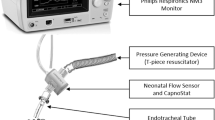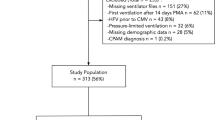Abstract
Objectives
We investigated the inflating pressures (Pinfl, the difference between peak inspiratory pressure and positive end-expiratory pressure) in infants receiving volume targeted ventilation.
Methods
Data were collected and analysed from 195 infants. Median Pinfl was determined before each blood gas (n = 3425). Ventilator parameters and blood gases were compared between periods when Pinfl was <5 mbar and periods when it was higher.
Results
1-hour periods when median Pinfl was <5 mbar occurred in 30% of the babies and were associated with similar tidal volumes and minutes ventilation as periods with higher Pinfl. Babies triggered more ventilator inflations, had more spontaneous breaths and lower oxygen requirement when Pinfl was low. There was no difference in blood gases when Pinfl was <5 mbar or when it was higher.
Conclusions
Episodes of low inflating pressure occur frequently in babies receiving volume targeted ventilation, but they do not lead to changes in blood gases.
This is a preview of subscription content, access via your institution
Access options
Subscribe to this journal
Receive 12 print issues and online access
$259.00 per year
only $21.58 per issue
Buy this article
- Purchase on Springer Link
- Instant access to full article PDF
Prices may be subject to local taxes which are calculated during checkout

Similar content being viewed by others
Data availability
Notebooks containing the Python code and explaining all steps of data processing and analysis have been uploaded to a GitHub code repository and are available at https://github.com/gbelteki/VG_minimal_inflating_pressure. Ventilator data are available from the corresponding author upon reasonable request and subject to research ethics committee approval.
References
van Kaam AH, De Luca D, Hentschel R, Hutten J, Sindelar R, Thome U, et al. Modes and strategies for providing conventional mechanical ventilation in neonates. Pediatr Res. 2021;90:957–62.
Belteki G, Morley CJ. Volume-Targeted Ventilation. Clin Perinatol. 2021;48:825–41.
Keszler M, Abubakar K. Volume guarantee: stability of tidal volume and incidence of hypocarbia. Pediatr Pulmonol. 2004;38:240–5.
Wong S, Wang H, Tepper R, Sokol GM, Rose R. Expired Tidal Volume Variation in Extremely Low Birth Weight and Very Low Birth Weight Infants on Volume-Targeted Ventilation. J Pediatr. 2019;207:248–51.
McCallion N, Lau R, Morley CJ, Dargaville PA. Neonatal volume guarantee ventilation: effects of spontaneous breathing, triggered and untriggered inflations. Arch Dis Child Fetal Neonatal Ed. 2008;93:F36–F39.
Belteki G, Széll A, Lantos L, Kovács G, Szántó G, Berényi A, et al. Volume-targeted ventilation with a Fabian ventilator: maintenance of tidal volumes and blood CO2. Arch Dis Child Fetal Neonatal Ed. 2020;105:253–8.
Klingenberg C, Wheeler KI, McCallion N, Morley CJ, Davis PG. Volume-targeted versus pressure-limited ventilation in neonates. Cochrane Database Syst Rev. 2017;10:CD003666.
Peng W, Zhu H, Shi H, Liu E. Volume-targeted ventilation is more suitable than pressure-limited ventilation for preterm infants: a systematic review and meta-analysis. Arch Dis Child Fetal Neonatal Ed. 2014;99:F158–F165.
Lucangelo U, Bernabé F, Blanch L. Respiratory mechanics derived from signals in the ventilator circuit. Respir Care. 2005;50:55–65.
Keszler M. Volume-targeted ventilation: one size does not fit all. Evidence-based recommendations for successful use. Arch Dis Child Fetal Neonatal Ed. 2019;104:F108–F112.
Carteaux G, Parfait M, Combet M, Haudebourg AF, Tuffet S, Mekontso Dessap A. Patient-Self Inflicted Lung Injury: A Practical Review. J Clin Med. 2021;10:2738.
Acknowledgements
We thank to Thomas Krueger, Kreske Brunckhorst and the engineers of Dräger Medical for help to export data from the ventilator. We thank to Professor Colin Morley and Dr Amanda Ogilvy-Stuart for her advice and comments on the manuscript.
Funding
This project has been indirectly supported by the National Institute of Health and Care Research, UK (NIHR).
Author information
Authors and Affiliations
Contributions
GB has designed the study, collected the ventilator data and performed the data analysis. VB and AJ participated in data analysis and interpretation. GB and VB wrote the paper. All authors approved the final version prior to submission.
Corresponding author
Ethics declarations
Competing interests
GB is a consultant to Vyaire Medical (Mettawa, IL, US) and Dräger Medical (Lübeck, Germany) and received payment for lectures and expert advice. Companies had no role in this study, preparation or approval of this manuscript and have not provided payment for this work. VB and AJ declare no conflict of interest.
Ethical approval and consent to participate
The study was approved by the Bromley (London) Research Ethics Committee of the Health Research Authority of the United Kingdom (reference: 18/LO/2182). Informed consent was gained from parents. All procedures were performed in accordance with the ethical standards of the amended Helsinki Declaration (1983).
Additional information
Publisher’s note Springer Nature remains neutral with regard to jurisdictional claims in published maps and institutional affiliations.
Rights and permissions
Springer Nature or its licensor (e.g. a society or other partner) holds exclusive rights to this article under a publishing agreement with the author(s) or other rightsholder(s); author self-archiving of the accepted manuscript version of this article is solely governed by the terms of such publishing agreement and applicable law.
About this article
Cite this article
Balog, V., Jermendy, A. & Belteki, G. Low inflating pressures during neonatal tidal volume targeted ventilation: occurrence and significance. J Perinatol 43, 1474–1480 (2023). https://doi.org/10.1038/s41372-023-01695-4
Received:
Revised:
Accepted:
Published:
Issue Date:
DOI: https://doi.org/10.1038/s41372-023-01695-4



